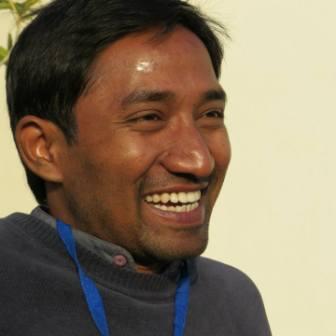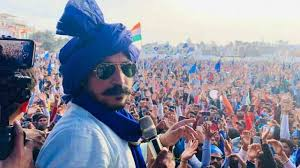Subodh Kunwer
When Enactment of a Tradition is met with Guns: Adivasi Demand for Constitutional Rights & Self-Rule
 On July 27, 2018, once again without engaging in any dialogue and discussion, the Raghubar Das government in Jharkhand has been unleashing force and violence on adivasi people under the pretext of repressing the ‘anti-national’ patthalgadi activities. This violent operation on adivasis in Khunti district was a clear manifestation of the deep rooted racialized attitude of the Raghubar Das government towards the adivasis. During this operation, one person has been shot dead by the police force, around 200 people have been injured and hundreds have been arrested by the police. In a recent move, the BJP government in Jharkhand has filed a case of sedition on 20 adivasi and human rights activists for writing in support of the patthalgadi movement.
On July 27, 2018, once again without engaging in any dialogue and discussion, the Raghubar Das government in Jharkhand has been unleashing force and violence on adivasi people under the pretext of repressing the ‘anti-national’ patthalgadi activities. This violent operation on adivasis in Khunti district was a clear manifestation of the deep rooted racialized attitude of the Raghubar Das government towards the adivasis. During this operation, one person has been shot dead by the police force, around 200 people have been injured and hundreds have been arrested by the police. In a recent move, the BJP government in Jharkhand has filed a case of sedition on 20 adivasi and human rights activists for writing in support of the patthalgadi movement.
The media, both regional and national, along with the “Outsider” Diku populace of Jharkhand have been constantly attempting to create a counter narrative against this very autonomous indigenous struggle through their powerful networks and instruments of information dissemination. What is shocking to know is the fact that protecting one’s own historical heritages and constitutional ideals of self-government in one of the scheduled areas has been termed as unconstitutional and anti-national. Will the pundits and experts speaking from spaces of influence explain the grounds on which they call this struggle as anti-national?
What is this Patthalgadi?
Patthalgadi is a ritual and social tradition of adivasi people of placing monoliths (stones) on the graves of ancestors. Patthalgadi tradition is also used to mark the boundary of the village, in memory of martyrs and ancestors, or to inform people about their history. Basically, a stone is being used to spread social, religious, political and cultural information to people.
According to the tradition of adivasi people, many types of pathalgadi are performed. For example, in Sasandiri Patthalgadi, when any member of the community dies, in the memory of the person they place a flat stone on the graveyard; Biridiri Patthalgadi is performed to mark the boundary of a village; Hukumdiri Patthalgadi is performed to inform the laws and rules of the society. The Sasandiri Patthalgadi (Burial Stone) also represents territorial belonging which says that their ancestors are sleeping in those lands hence those lands belong to them.
Since the beginning of the reinvented patthalgadi tradition the government, the mainstream media and the ‘mainstream’ society are terming the act of patthalgadi as secessionist, seditious, unconstitutional, against development, against the nation and so on. The Government and the Diku society are alleging that the pathhalgadi performance is used to mislead the children and it helps in indoctrinating ‘distorted’ education amongst them. The state government and the ‘mainstream’ media have also alleged that opium is being cultivated in the name of patthalgadi. Whereas adivasi people claim that they are simply performing their tradition. They are also spreading information about the provisions given by the Indian Constitution through the patthalgadi tradition. They argue that the provisions of the Indian constitution recognize the autonomy of their traditional social and political system. Through patthalgadi, adivasi people of the area are declaring gram-sabhas as the only sovereign authority, mentioning the PESA [the Panchayats (Extension to Scheduled Areas) Act], the provisions under Fifth Schedule and other articles of the constitution.
Why is the performance of this tradition making the government highly anxious, even though patthalgadi is just talking about the constitutional provisions and acts? What is happening in adivasi regions, ‘India’ does not know or does not even have any will to know. What is there in this patthalgadi tradition that the government has to arrest many adivasi activists and people? What is there in this patthalgadi that is haunting the dominant and ‘mainstream’ society? What is there in this patthalgadi tradition that the dominant and ‘mainstream’ India brazenly brings out their racist and hate-filled mindset towards adivasi people shamelessly?

There are several reasons in the background of this movement. The current BJP government’s attempt to change the Chota Nagpur Tenancy Act, 1908 and Santhal Pargana Tenancy act, 1949 is considered one of the main reasons behind fuelling the patthalgadi movement. The establishment of the Land Bank scheme for the Momentum Jharkhand Project is also one of the main reasons. The government has brought Sarana Sthal land (sacred grove comprising mainly Sal trees, a common religious place), Sasandiri land (the burial ground of adivasis), Khunkatti land (right to hold jungle land for cultivation, the land owned by cleaning forests) under this new scheme of the Land Bank.
The Raghubar Das government has also passed the Jharkhand’s Religious Freedom Bill, 2017 targeting the religious minorities and is trying to divide adivasi people along religious and communal lines. These are a few main reasons which triggered the adivasi people to raise their voice against the government. However there has always been an historical dissatisfaction and a feeling of breach of trust amongst adivasi people towards the Indian State and the Dikus – outsiders, exploiters. The Indian state has always oppressed and displaced adivasi people in the name of so-called development. Adivasis are the one who have suffered most for the development of the Indian nation; the development which has only benefited the capitalist and Brahmin class.
There has always been a tension between the government and adivasi people for the cause of land, forest, water and their culture. Thus, a war has been going on between adivasi (indigenous) people and Diku people. In the context of performing patthalgadi, the act again is depicting the same struggle for self-rule for which indigenous people have always been fighting. The act of patthalgadi has again brought the struggle of their forefathers (Tilka Manjhi, Sidu and Kanhu Murmu, Birsa Munda etc.) who fought for freedom and ownership (Haq) on Jal, Jungle and Jamin (River, Forest and Land). It appears as if the act of patthalgadi is mocking the modern education system loud and clear, saying we don’t have a ‘scripted’ knowledge system but our traditions, festivals, rituals, myths are more profound than your ‘scripted’ knowledge. Our traditions, festivals, rituals, myths have the capacity to nurture the consciousness of dignity, freedom and self-rule at anytime.
The way in which, at present, adivasi people are performing their tradition of patthalgadi, has gone beyond the simple act of performing the tradition and is informing people about constitutional provisions and acts. For the dominant and mainstream society, it has become an act of sedition, an act against the Indian State. How can they (gram-sabhas) perform patthalgadi and issue an order saying no outsiders are allowed without informing the gram-sabha? This question is haunting the ‘mainstream’ society. Almost all the news channels, media houses, government, and the so-called civil society organisations are crying for their helplessness.
The enactment of the tradition of patthalgadi has become a site of declaration of self-rule, and at the same time it invokes a sense of mobilization for the adivasi community. The patthalgadi process recalls and activates the sense of the memory of people and their imagination of the landscape- ‘Munda Disum (The land/country of Munda people).’ In a way, the assertion and the declaration show how the sense of past mobilizes through the tradition of patthalgadi and brings the State to negotiate at one stage. Several times, the myth, rituals and the memories are projected as continuing in real movements and do not just remain at the level of imagination. This traditional enactment became an important part of the movement: for instance, in order to resist displacement, patthalgadi and its imagination of the landscape has been used to inform the community and mobilize them against government injustices. The famous example is the Jharkhand Jungle Bachao Andolan (‘save the forest’ movement in the 1980s) in the Singhbhum area of Jharkhand in which they mobilized and resisted against the scheme of cutting of Sal trees and planting Sagwan trees in their place. Their belief in relationship with land and forest shows the idea that the exploitation of these life affirming entities also threatens their identity and existence. For example, the cutting of Sal trees has been linked with the Asur myth of Munda community where the Asurs were using Sal trees to melt iron and as a result the earth got burned.

At the base of such conflicts appears to be a different notion of forest and land: a source of power and territorial legitimacy for the adivasi and a source of revenue for the State. The patthalgadi movement again also reflects the different notion of ideology in terms of conceptualization and imagining land, forest and river, the different notion and understanding of the process of development. The present Jharkhand government (Bharatya Janata Party government) sees the Sarna Sthals, the Sasandiris, Akhra Sthals, Khuntkatti land — and all these socio-religious spaces as Land Banks of the State. Legitimacy derives not from a reciprocal, co-operative, spiritual relationship between people and land & forest, but unidirectionally from an exploitative central political authority.
In recent news coverage, the honorable Home Minister Rajnath Singh was shown saying ‘there must be a direct dialogue with adivasi population of the area.’ What a great idea! Raghubar Das government sends police and paramilitary forces into tribal areas and they blatantly open fire on tribal people; arrest them. People are being threatened in Godda district in Jharkhand for not giving signatures in favour of the Adani company for land and you are talking of dialogue. Whenever the downtrodden population demands justice and their rights, each and every time, we hear this brutal sentence. Why do these peace dialogues never work? The adivasi-moolvasi people of Jharkhand want peace but not the peace the state or the present government seeks. Their notion of peace is something different, it carries the philosophy of adivasiyat, of which they and their children may be proud.
Patthalgadi, which is haunting the government, the dominant Diku consciousness; which is completely constitutional, yet goes beyond the constitution; this simple act of writing down the constitutional provisions on monoliths has become an act of assertion and resistance which over and over again has exposed the fragile character of the nation-state that India has always been.
It is believed that after the independence, a new democratic era has begun for India, but everything is still the same amongst the adivasi population and region. The state and the government have been saying that they are working according to the constitution but the powerful, the dikus, are using the constitution only for their own interests. The police and administration assume their old form of colonial arrogance and haughtiness. Once again the Jharkhand region has started to boil. The unrest in adivasi areas can only be addressed by delivering the ownership rights over water, forests and land to the adivasi people.
~~~
Subodh Kunwer is from Jharkhand and is pursuing Ph.D. at the School of Arts and Aesthetics, JNU. His research area comprises of cultural practices, anti-caste traditions, and indigenous politics. He is currently working as a member of BAPSA, JNU.
Pictures courtesy: the internet.










